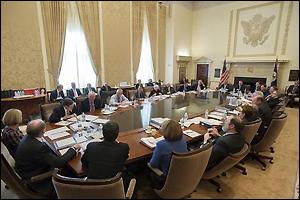By Pam Martens and Russ Martens: October 30, 2014
Back on June 25 of this year, Wall Street On Parade ran the following headline: “BOE’s Carney: Inflated Central Bank Balance Sheet the New Normal; Expect to Hear the Same Conclusion from the U.S. Fed.”
The day before our headline, Bank of England Governor, Mark Carney, had just explained to Parliament why their central bank’s balance sheet, bloated through quantitative easing, was not going to be shrinking anytime soon.
Carney: “…I would define – picking up on what my colleagues have said – pre-crisis position as a position that’s consistent with the normal course of liquidity requirements of the banking system…What has changed, to the good, in terms of the banking system here is that through regulation and supervision we have put much more responsibility on the banks themselves to hold liquidity to manage liquidity shocks. And, as a consequence of that, their demand for reserves can be expected to be higher. The further consequence of that is that the balance sheet of the Bank of England will be larger…”
Translation: We have no idea how to unwind this mess any better than the Americans do.
We commented in the article that: “There is a very real suspicion that Carney was simply laying the groundwork for Fed Chair Janet Yellen to begin to slip the same hints into her forthcoming speeches.”
Last month at Fed Chair Janet Yellen’s September 17 press conference, in response to a question from Ylan Mui of the Washington Post, Yellen said: “If we were only to shrink our balance sheet by ceasing reinvestments, it would probably take—to get back to levels of reserve balances that we had before the crisis—I’m not sure we will go that low, but we’ve said that we will try to shrink our balance sheet to the lowest levels consistent with the efficient and effective implementation of policy—it could take to the end of the decade to achieve those levels.”
The end of the decade is five years away.
Yesterday, the Fed, in its Federal Open Market Committee (FOMC) statement, said it was going to conclude QE3, its quantitative easing program that has been buying U.S. Treasury notes and bonds and mortgage-backed securities issued by Federal agencies, at the end of this month. However, its balance sheet was not going to shrink anytime soon because it was going to continue to reinvest the principal of both classes of securities as they matured or paid down.
U.S. Treasuries have a fixed maturity date. Mortgage-backed securities, however, despite having a stated maturity date, pay down principal when a mortgage-holder in the pool pays off their mortgage, refinances, or sells their home – thus extinguishing the mortgage.
The Fed said its policy of continuing reinvestment of maturing or paid down principal “should help maintain accommodative financial conditions.”
As of October 22, according to a listing at the Federal Reserve Bank of New York, the Fed is holding $1.7 trillion of mortgage-backed securities (MBS) and $2.3 trillion of U.S. Treasury notes and bonds. (It holds other types of Federal debt as well.) While the pay down on the MBS is somewhat unpredictable, the maturity of Treasury notes and bonds is not.
Included among the Fed’s Treasury holdings are more than $475 billion (almost half a trillion dollars) of bonds maturing from 2036 to 2044 – 22 to 30 years from now.
Talk of QE-Infinity may not be so far fetched at all.


